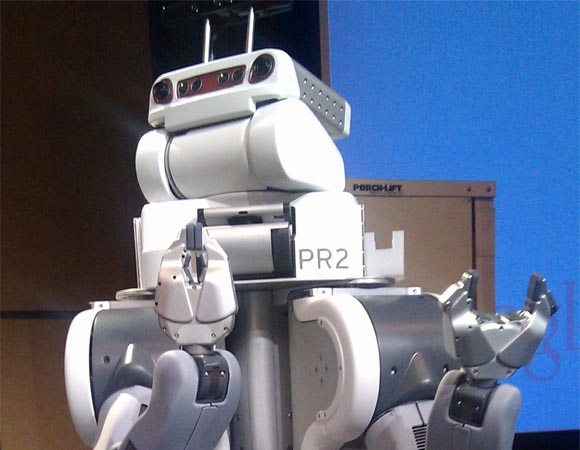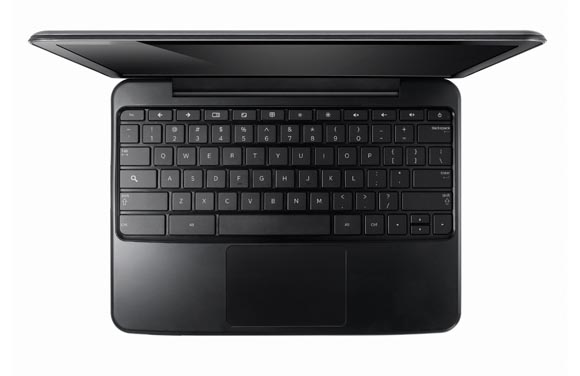Google I/O 2011: 5 things to keep watching
From Chromebooks to Arduino to bots: Mike Loukides examines I/O's big themes.
All the robots …
More than anything else, I’ll remember the robots at <a href="
“>Google I/O 2011 — from the minuscule Arduino bots at the After Dark party to the massive PR2, a full-sized humanoid robot. Perhaps I’m biased because of my daughter’s participation in FIRST Robotics (go Apple Pi 2067), and perhaps it’s just because robots are among the coolest toys possible, but it was hard to avoid robotics. And the cute Hasbro Androids rolling around while balancing on two wheels were hard to resist.

The PR2 robot at Google I/O 2011
But that’s getting ahead of the story. This was my fourth I/O. As I’ve come to expect, it’s a high-energy, exciting conference with a lot of first-rate technical content. The keynotes were less ambitious than the last two years, and with good reason. After all the excitement around Wave in 2009, Google has dropped it (though ideas from Wave are starting to reappear in other Google apps), and after wowing us with Google TV last year, that product is off to a slow start at best. So Google limited themselves to less ambitious announcements and demos — wisely, I think.
Android housekeeping
The keynotes started with a series of minor announcements that were necessary, and important to Android developers, but not particularly exciting. Google will be providing some tooling and library improvements that limit the problem of Android API fragmentation. Android has fragmented because it has succeeded, and to that extent I think whining about fragmentation is just that. Would you rather work on a fragmented platform with 100 million devices, or in a monoculture with a few hundred thousand? But tools to help developers deal with the problems of success are a no-brainer.
It’s also good to hear that Google has a plan to bring carriers in line about device upgrades. Getting carriers to upgrade devices promptly is a serious problem. I’m skeptical about whether Google has really solved the problem; network carriers can be awfully recalcitrant. We’ll see. Finally, it was good to hear that Android 3.1 (“Ice Cream Sandwich”) will be released as open-source code by the end of the year. I’m not terribly religious about open source, but it is A Good Thing, and Google’s reluctance to open source Honeycomb has been an unnecessary distraction.
Movies and music: OK, but unimpressive
Google’s movie rental service and Music Beta were OK, but unimpressive.
Google will have to go to some lengths to compete with Netflix for streaming movie rentals (though the ability to “pin” downloads for offline viewing is a nice feature). And while Google’s cloud capabilities are second to none, including Amazon, they really only supply cloud storage, streaming, and a more capable player. That would be enough if Amazon didn’t already offer a streaming music service for virtually any device, along with the ability to purchase music. Yes, I understand that Google is at a disadvantage; according to one engineer, they had the software ready a year ago, but have been unable to reach an agreement with the music labels.
 Amazon is risking being taken to court by the record labels, but they have one huge advantage that Google lacks: they already account for the lion’s share of CD sales. Google has to move forward with or without the labels, and the music industry may well decide to sit on the sidelines and pout about “theft” rather than build new business models that might actually work; but it still makes for a product that’s less than it could, and should, be.
Amazon is risking being taken to court by the record labels, but they have one huge advantage that Google lacks: they already account for the lion’s share of CD sales. Google has to move forward with or without the labels, and the music industry may well decide to sit on the sidelines and pout about “theft” rather than build new business models that might actually work; but it still makes for a product that’s less than it could, and should, be.
The Accessory Development Kit is a big deal
The Accessory Development Kit (ADK) for Android was the most important announcement on the first day, if not of the entire conference. And yes, most of those robots wandering around were controlled by Android phones. The time is ripe for a wave of creativity around interfacing external devices to phones and tablets. It’s a game changer. A phone or a tablet can become a personal data collection device, a general control, whatever you can imagine. While I don’t use an exercise bike, using a phone to record and track your progress, save exercise programs, and so on, is a compelling application.
By choosing Arduino as the hardware platform for the ADK, Google has chosen to make Android hacking as easy as possible, as open as it can be. As Phil Torrone points out, there are already more than 300,000 Arduinos “in the wild”, and a corresponding number of developers already up to speed and ready to hack. I said a “wave of creativity,” but it’s not going to be a wave, it’s going to be a flood. Furthermore, the accessory API takes Android into territory that the iOS world is unlikely to explore. I cannot imagine Apple allowing an iOS attachment that is not Apple-branded.
Chromebook and developers
 The Samsung 5 3G Chromebook
The Samsung 5 3G Chromebook.
The second day’s keynotes focused on Chrome, ChromeOS, and Chromebooks. I never got one of last year’s experimental CR48 Chromebooks; the unit they’ll be sending to attendees later in the year sounds much more impressive. I find the Chromebook vision compelling, because it delivers on something I’ve long thought was necessary. I have several laptop, desktop, and tablet computers in my household (more than there are people), and I also take care of my mother’s computing needs (limited to email). All this hardware requires a lot of local management: backups, virus protection, software installation, updates, all the hassle that we’re all familiar with. In an ideal world, all of these tasks would be handled by professionals. I know few users, even the most sophisticated, who have adequate backups. I also know few users who haven’t lost photos, music, documents, whatever when a disk suddenly fails. I survived my last disk failure unscathed, thanks to Apple’s TimeMachine. But the answer isn’t better backup software and better backup devices, particularly when computing equipment is so mobile. The answer is to put these functions back where they belong: in a data center, managed by professionals. ChromeOS is very much the right vision.
Whether or not Google will succeed with ChromeOS is an open question. ChromeOS doesn’t look like an environment where you can write a whole lot of Java or C code and compile and install the results, so it isn’t immediately useful for developers. Google’s route to adoption runs through the software development community. If software development on a ChromeOS device is difficult (and I don’t just mean development for the device itself), Google will have an uphill battle, regardless of whether the device is a better fit for my mother.
Still, though, Google finds friends in unlikely places. If solid state disks don’t become a lot more reliable, if Apple persists in requiring developers to download a 4 GB XTools package from their store (the $5 charge isn’t a big deal, but the size of the download is), and if Google can build a cloud-based general-purpose software development environment, I can imagine a 4G-enabled Chromebook becoming the darling of the developer community. Light, with broadband wireless, USB and HDMI, and a (hypothetical) suite of software development tools: what’s not to like? Chromebooks could also be compelling as remote enterprise devices: bigger, easier to use, and less limiting than tablets, while much less expensive than Windows laptops. I don’t see the Chromebook as a “windows killer” any more than I think it’s an Apple killer. To challenge Microsoft, Google would need significantly more enterprise adoption for their cloud services. Currently Google apps are at best a tolerable replacement for Office. But again, it’s a possible future, and an intriguing one.
JavaScript is a first-class programming language
Of course, the importance of Chrome isn’t just ChromeOS. In keynotes and in sessions, Google demonstrated many improvements in HTML5 and JavaScript performance and features. While server-side software isn’t an important topic at I/O, it’s important that their V8 JavaScript engine is the enabling technology behind Node.js, which is now revolutionizing web development. With tools like V8, the Closure and Traceur compilers, and their involvement in the development of HTML5, Google has led the way in making JavaScript a first-class programming language, not just a bit of glue for web pages. I wouldn’t necessarily say that JavaScript is being used any more than it was, but if you’ve been watching, you’ve probably noticed that the way JavaScript is used has changed and matured in the last year.
A few more thoughts on I/O
I won’t say much about the giveaways beyond this: When a $400 conference ticket gets you $1,000 worth of hardware, conference registration turns into a feeding frenzy. Google has created a problem for themselves.
I do want to point to one important development that wasn’t represented. Just before the conference, Jacek Ambroziak released his eCarrel ebook reader in the Android store, for both tablets and phones. I’ve had an early version on my phone since February, and it’s by far the best reader I’ve seen. It was good on the phone, but reading a book on a cell phone is uncomfortable at best. On the tablets, eCarrel is a great experience. If readers are the killer app for tablets, eCarrel is a glimpse of the future.
All in all, I/O was exciting, if not as flashy as the past two years. Whether or not ChromeOS succeeds, it has the potential to bring “it just works” computing to a new level, and a class of users. The Android Accessory API takes the Android world into a new class of applications that could fundamentally change what we expect of our mobile devices. It’s a future that’s both more realistic than last year’s TV-based vision, and more radical.
Related:
Why Google Choosing Arduino Matters
Arduino is a building block for the world to come
Fun with RFID and NFC at Google I/O BootC
Android Controlled 3D Printed Slalombot
Why fragmentation is a good sign for Android

 Amazon is risking being taken to court by the record labels, but they have one huge advantage that Google lacks: they already account for the lion’s share of CD sales. Google has to move forward with or without the labels, and the music industry may well decide to sit on the sidelines and pout about “theft” rather than build new business models that might actually work; but it still makes for a product that’s less than it could, and should, be.
Amazon is risking being taken to court by the record labels, but they have one huge advantage that Google lacks: they already account for the lion’s share of CD sales. Google has to move forward with or without the labels, and the music industry may well decide to sit on the sidelines and pout about “theft” rather than build new business models that might actually work; but it still makes for a product that’s less than it could, and should, be.
